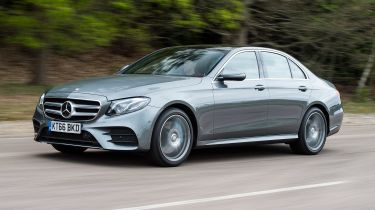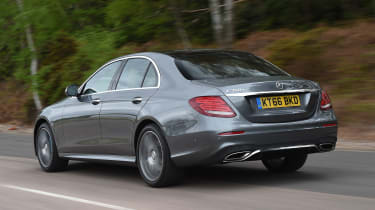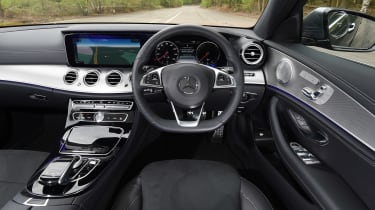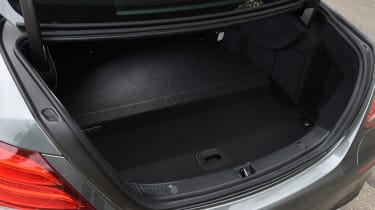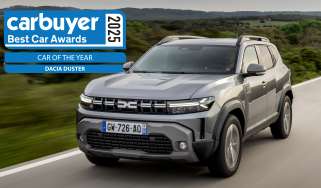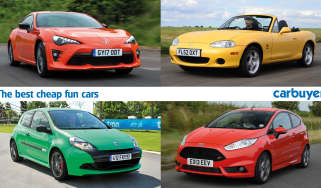Mercedes E 350e hybrid (2016-2018)
“The Mercedes E-Class is a fine all-rounder and the E350e makes extra sense as a company car”
Pros
- Low company-car tax
- Beautiful interior
- Quiet engine
Cons
- High list price
- Unexciting to drive
- Restricted boot space
The Mercedes E-Class competes for the same executive-car buyers as the BMW 5 Series, so offering a plug-in hybrid version was a natural step. Although the E-Class has always been popular among private buyers looking for something more spacious than the Mercedes C-Class saloon, business users make up a large portion of the E-Class audience, so a plug-in hybrid holds a lot of appeal.
Until recently, diesel models were the default choice for company-car users, but thanks to the way Benefit-in-Kind (BiK) company-car tax is levied according to CO2 emissions, plug-in hybrids are becoming increasingly popular. As the official CO2 figures for the E350e are far lower than even the entry-level diesel, a significantly lower rate of company-car tax is payable.
In urban areas, where a plug-in hybrid car can best make use of its technology, the E350e is a far ‘greener’ transport solution than a pure petrol or diesel model, thanks to a complete absence of exhaust gases when electric mode is engaged. Mercedes claims a 21-mile all-electric range is possible if you begin your journey with a fully charged battery.
So, there are clear environmental advantages for all and financial rewards for company-car users – but what about private buyers? If you happen to live in an urban location where snarled-up traffic is a regular hazard, you could stand to make big savings on fuel. If the range is sufficient, your daily drive might not use any fuel whatsoever – the E350e’s claimed overall fuel consumption of 134.5mpg assumes using electric power wherever possible.
More reviews
However, it may take a while for that fuel saving to offset the E350e’s higher purchase price. Although its CO2 figure means it’s eligible for a £2,500 UK government plug-in vehicle grant, it’s still around £5,000 more expensive to buy than the entry-level E200d – which returns a claimed 67.3mpg overall.
Like any other E-Class, it’s extremely comfortable on fast highways and urban byways alike, and its extra quietness may make it worth the extra – particularly when using near-silent electric mode. The E-Class can’t match the nimble road manners of the BMW 5 Series, though, and the extra weight of the plug-in hybrid technology takes its toll on the way the E350e handles corners.
Apart from those differences, the E350e is E-Class business as usual, with a magnificent interior that’s plush enough to make you wonder if the flagship Mercedes S-Class is necessary. Depending on the interior decor you choose, it can look either restrained or aggressive, and optional extras can transform the dashboard to truly hi-tech effect.
Be mindful, though, if you choose the more eye-catching AMG-Line version – its bigger wheels increase CO2 output, resulting in a 2% hike in BiK. Many will think this an investment worth making for the greater presence it has on your driveway.
MPG, running costs & CO2
The most important statistic when it comes to discussing plug-in hybrid cars is CO2 emissions. With lower claimed emissions than petrols or diesels, they’re particularly suited to urban conditions, where they make far less contribution to inner-city pollution.
To encourage the take-up of low-emissions cars, Benefit-in-Kind (BiK) tax strongly favours those with the lowest claimed CO2 figures. The E350e SE sneaks into the lowest 9% band with a 49g/km emissions rating. The higher drag of the AMG Line’s bigger wheels increases emissions to 57g/km and places it in the 11% bracket.
This represents a big drop in company-car tax compared to the 21%-bracketed entry-level E200d diesel, even once the higher taxable (P11D) value of the E350e is taken into account.
The latter point will be frustrating to private buyers, though – even once the Government plug-in car grant of £2,500 is taken off, it may take a while for the fuel savings possible in the E350e to recoup the additional cost of choosing plug-in hybrid over diesel in the first place. With a list price of over £40,000, the £10 reduction in VED to £130 is engulfed by the £310 surcharge payable the first five times you renew the E350e’s road tax, too.
Supporting its claimed overall fuel economy of 134.5mpg, urban drivers may find that the E350e’s 21-mile claimed all-electric range is sufficient that the petrol engine is rarely called into action. A full charge takes around three hours from a standard domestic mains socket, and an optional fast-charger can reduce this time by half. However, we found 15 miles to be a more realistic all-electric range and once out of town and above 60mph or so, you’re more likely to see fuel economy akin to any other 2.0-litre petrol engine.
Other running costs are similar to other Mercedes E-Class models. Servicing is required once a year or 15,500 miles – whichever comes first – and contracts are available to spread the cost of maintenance. There’s a three-year/unlimited-mileage warranty that can be extended at extra charge, while the plug-in hybrid components have a separate six-year/62,500-mile warranty.
Engines, drive & performance
Geared strongly towards comfort and relaxation, the Mercedes E-Class isn’t as sharp or responsive to drive as the BMW 5 Series or Jaguar XF, but is still a pleasure to drive, whether it be a long, peaceful motorway journey or a more energetic back-road sprint.
It’s a shame that the E350e’s extra weight blunts its responses further, though – it feels a little less nimble than its petrol and diesel-powered stablemates. The brakes are strong and the steering weighty and precise enough to inspire confidence, but the E350e is unlikely to give enthusiastic drivers much reason to grin.
The smooth ride remains impressive, though, and passenger comfort is assured, particularly in the SE model. The larger wheels and low-profile tyres of the AMG Line are rather more prone to crashing into potholes and transmitting shocks to occupants.
The E350e’s plug-in hybrid system consists of a 2.0-litre petrol engine, an electric motor and a bank of lithium-ion batteries. Working together, a total of 282bhp is available, which means 0-62mph is possible in just 6.2 seconds – appreciably faster than most of the diesel engines in the range. However, as speed increases, the electric motor’s contribution is reduced, and overtaking doesn’t feel much more urgent than in a typical diesel car. You might also prefer a more evocative exhaust note than the E350e’s four-cylinder rasp.
Interior & comfort
The Mercedes E350e excels in the same area as other E-Class models – its interior is among the very best you can buy at any price. The first thing you notice is the presentation – which is striking and attractive – and then you feel the quality: every surface is a pleasure to touch unless you really hunt for the patchier quality of out-of-the-way parts.
The strongest overall impression, though, comes from the E-Class’ general layout, particularly if you tick a few key items on the lengthy options list. The E350e comes with the COMAND Online infotainment system, which provides navigation, DAB radio, Bluetooth and media connectivity and a variety of online services on a high-resolution 12.3-inch display.
For a little extra, though, you can further extend the hi-tech impression by choosing second 12.3-inch display in place of the standard analogue instruments. Its black surround gives the impression that the display runs seamlessly across the dashboard, integrating driving and infotainment information in a single panoramic screen. It looks fantastic and is a pleasure to use.
Like all E-Class models, the E350e is a well-equipped car. Dual-zone climate control, heated front seats, keyless go, a reversing camera and leather upholstery are all standard equipment, and you get a unique set of 18-inch alloy wheels.
Practicality & boot space
The E-Class wouldn’t be anywhere near as comfortable if it had a cramped interior. As it is, you’re promised plenty of space whether seated in the front or back and whether you’re the driver or a passenger.
The doors open wide and there’s little ducking required to get into the back seat. Here, you’ll find plenty of head and legroom – enough to beat a BMW 5 Series or Audi A6. The occupant of the centre rear seat sits atop a sizeable floor hump, though: it houses the driveshaft and deprives passengers of anywhere to place their feet. For this reason, the centre rear seat is best suited to children.
If you choose the optional wireless device charging bay, it occupies a cubby ahead of the centrally mounted rotary controller for the infotainment system, while there’s a large storage area under the central armrest as well as a generous dashboard. Rear-seat passengers have seatback nets ahead of them and door pockets big enough for a wallet or smartphone.
It’s rather a shame the E350e plug-in hybrid is only available in saloon form, as the boot is compromised compared to its conventionally fuelled stablemates. While those enjoy a luggage capacity of 540 litres, here it’s reduced to 400 litres by the battery pack mounted under the boot floor. A folding rear seat is optional, though, so you can expand the boot at expense of passenger capacity.
Reliability & safety
While Mercedes has long enjoyed a reputation for quality, its record for owner satisfaction isn’t quite as strong as it should be.
In our 2017 Driver Power owner satisfaction survey, Mercedes finished in 21st place overall out of 27 brands covered. Among the company’s results were a 24th-place finish for running costs and a disappointing 22nd-place finish for driver involvement and steering response.
For overall reliability, it was ranked 16th overall out of 27 brands. A total of 15.2% of owners reported experiencing one or more faults with their Mercedes during the first year of ownership. However, these were the findings of Mercedes owners as a whole – too few E-Class owners responded for the car to be represented in our survey individually.
The E350e enjoys the same excellent five-star Euro NCAP safety rating as every other model in the E-Class range. It’s still well worth adding the additional safety offered by the Driving Assistance package, though – this includes an autonomous emergency braking system that greatly reduces the risk of a collision at low speeds.
Price, value for money & options
The Mercedes E350e plug-in hybrid has two main rivals: the BMW 530e iPerformance and the Infiniti Q70 plug-in hybrid. All three models are priced similarly and offer the same tax advantages to company-car drivers and all can potentially deliver fuel savings for those who mainly drive where traffic often grinds to a halt.
However, the three cars have their own nuances that define them and you’re as likely to make a choice based on looks and image as you are on any specific virtues. The Mercedes can’t match the BMW for driver appeal, but has the edge for interior ambience, while both are truly accomplished all-rounders. The Infiniti makes an interesting alternative – as there are far fewer on the road, you’ll certainly stand out from the crowd if you choose one.
If you choose the Mercedes, you can place your stamp on it from a long list of optional extras. The Driving Assistance Package includes autonomous emergency braking, active cruise control, blind-spot assistance and active lane-keeping assistance, which can help make steering movements to stay in lane. There are also endless options for personalising the interior design, improving the sound system, seat comfort and interior ambience – including an AirBalance fragrance dispenser.

